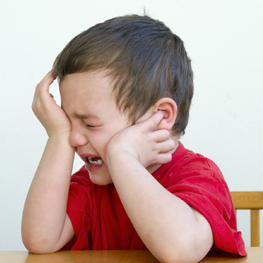
Effective discipline of young children requires knowledge about the development of children. Normal toddler behavior is often viewed as ‘misbehavior’ by parents who do not understand the physical, cognitive, social and emotional capabilities and limitations of toddlers. Research shows that children under age five comply (‘listen’) to parent requests about 40 per cent of the time. This is normal child behavior for that age, and does not require ‘teaching,’ ‘discipline’ or ‘punishment.’ This normal behavior will change as the child matures.
Children will develop self-control naturally with age. Until then, parents can childproof the local environment to make it safer and enjoyable, and can redirect the child. Children need adult help to calm down as they have yet to learn self-soothing, which is a learned skill that comes with age and practice.
Toddlers have poor understanding of rules until they reach about age three. Even the word ‘no’ is counterproductive, in that directing the child not to do something tends to inspire the child to actually do it! Toddlers also have poor impulse control. This is a factor of executive function. Even though they understand the rule, they don’t have the self-control to hold back until about age five. They are going through a necessary developmental stage to explore their surroundings with all their senses and want to taste, touch and smell everything. Toddlers may seem to be ignoring or deliberately disobeying you but in reality, they are just doing their normal job of exploring, which stimulates development of their brains.
Normal characteristics include:
Toddlers do not possess abstract thinking skills. Rules are abstract, and a ‘don’t’ rule is a double abstract, which draws a toddler’s attention to the very action you are attempting to forbid.
Toddlers are in the here-and-now. Memories of rules known yesterday have been displaced.
Toddlers cannot multitask. They can only hold a few thoughts in their head at once.
Toddlers are driven to explore. Everything in their being says ‘touch, taste, smell, look, hear!’
Toddlers have almost no impulse control. Their immature brains do not allow them to restrain themselves.
Toddlers do not understand cause and effect. They can’t relate their action to mom’s anger. Reflection skills do not develop until age seven.
The best discipline tool for young children is to understand their development and redirect their behavior. Childproofing helps too because when a desired item is out of sight for a young child, it is also out of mind.
Temper tantrums
Temper tantrums occur when your child is overwhelmed and over-stimulated. The child feels frustrated and angry, and expresses those feelings through body language, instead of words. Tantrums are part of normal behavior for a child between the ages of 10 months and 4, decreasing in frequency with age.
Prevent tantrums - Provide rest, sleep, food or stimulation as needed. Don’t go shopping with a tired, cranky, hungry child. Watch for and prevent triggers. Change the activity. If your child is getting tired, hungry or cranky, offer a juice box (to raise blood sugar) and a protein snack. Try cuddling on your lap with a good book - a great way to calm down, gain literacy skills and enjoy some connecting quiet time together. Try to meet needs as soon as possible. Sometimes boredom can’t be alleviated. Get creative and invent ways for children to pass the time.
Handle the tantrum - It often helps to ignore the tantrum, and carry on with your activity as if nothing is happening. If you have denied the child an item, this is not the time to hand it over! Other methods are to hold the child and move to a safe, quiet place. Encourage feelings and expression of feelings. Say, “You’re angry. I’ll stay with you while you calm down. It’s okay to be angry. I know you are feeling frustrated.” Use a gentle but firm voice. Encourage deep breaths.
After the tantrum - Label your child’s emotions and provide words to develop a vocabulary of feelings. Ask, “Were you angry when you couldn’t have that cookie? How can we express our anger? [Here] is something to do.” The toddler usually understands the intent of the question and feels understood, and will later learn to use the words of feelings instead of the body language of a tantrum.
In any situation that involves discipline of a child, remember three steps:
Step 1: Calm yourself. Take deep breaths, drop everything, dress your child, take the stroller and go for a walk or put on a video to distract you or your child.
Step 2: Calm the child. Redirect to another activity or sit and breathe deeply together or hold the child.
Step 3: Solve the problem. Childproof, redirect, substitute, distract, comfort, talk, prevent and model.
You will make much better parenting decisions when you and your children are calm.
Stay tuned for Part 2 - Discipline for Older Children.
For more information on Judy’s suggestions for effective discipline and to register for her next free Webinar on Discipline, taking place Thursday, September 17, 2015 at 8pm, click on ‘Webinars’ at professionalparenting.ca.
Judy, CCFE (Certified Canadian Family Educator), provides live webinars and is the bestselling print author of Discipline Without Distress and Parenting With Patience. Contact her at professionalparenting.ca.
Calgary’s Child Magazine © 2024 Calgary’s Child